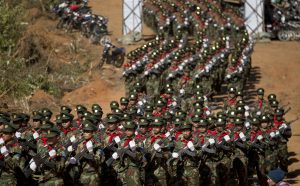This week, the International Crisis Group (ICG) published a report on the delicate and fluid political situation in the northern part of Myanmar’s Shan State. The report’s focus was on the rise of the Ta’ang National Liberation Army (TNLA), which was founded in 2009 and has since grown into one of the best organized and most effective ethnic armed groups in eastern Myanmar.
The report documents how the TNLA has capitalized on the chaos and widening conflict since the coup of February 2021 to recruit fighters and expand the territory under its control, which according to the ICG, now includes encompasses “significant parts of at least eight townships.”
“The 2021 coup has further strengthened the TNLA’s hand,” the report states. “Busy fighting on other fronts, the Myanmar military has largely withdrawn from the northern Shan State battlefield, enabling the group and its allies to gain territory.” In the areas under its control, the group has managed to establish a rudimentary administrative apparatus, including judicial bodies and health and education services.
The TNLA, which was founded in 2009 as the armed wing of the Palaung State Liberation Front, grew out of a decades-long struggle of the Ta’ang ethnic minority group (known in Burmese as the Palaung) for greater autonomy from the central state. The group won local popularity for its staunch anti-drugs policy – a rarity in a region of Myanmar that is the source of much of the world’s supply of amphetamine-type stimulants and a decent proportion of its heroin – which it showcased by burning opium poppy crops in front of the international press.
The TNLA soon came to be a part of the so-called Brotherhood Alliance, which also includes the Arakan Army, an armed rebel group mostly based in Rakhine State in Myanmar’s west, and the Myanmar National Democratic Alliance Army, which controls the small territory of Kokang in northern Shan State.
Consistent with its goal of Ta’ang autonomy, the TNLA, which boasts an estimated 10,000-15,000 personnel under arms, has attempted to “stake out a middle ground” on the post-coup conflict.
This balancing act reflects the “complex environment” in which ethnic armed groups in Shan State are forced to operate, the ICG report states. On the one hand, the group’s desire for an autonomous Ta’ang state has made it supportive of the federal system advocated by the opposition National Unity Government (NUG), as well as the NUG’s agenda of overturning the coup regime and extricating the military from Myanmar’s political and economic life. Since the coup, the TNLA has banned the sale of products from military-owned companies within its territories. It has expelled the Restoration Council of Shan State (RCSS), a rival ethnic armed group that is aligned with the Myanmar military, and given sanctuary to opposition figures fleeing from the Bamar majority regions of the country. It has also helped train and equip local People’s Defense Force militias, which have sprung up to oppose the military administration.
At the same time, the report notes, the TNLA leadership is not optimistic that the military is can be defeated outright, and so has hedged its bets somewhat. Despite the ever-present risk of an outbreak of fighting, the report states, the group “now tries to steer clear of clashes with the military,” and has met with representatives from the coup regime. “Although the Ta’ang group has been an important source of training and weapons for new forces resisting the junta,” the report adds, “it has avoided publicizing this support.”
Also weighing into the equation is China, which has longstanding ties with many of the ethnic armed groups operating along its lengthy border with Shan State. Concerned above all about the stability of this region, a precondition for the construction of the China Myanmar Economic Corridor, an infrastructure project linking Yunnan to the Indian Ocean, Beijing has pressured the TNLA and other members of the Brotherhood Alliance to come to an accommodation with the junta. Under Chinese inducement, the three groups have held talks with regime officials, though these have so far yielded little.
Through its examination of the TNLA’s evolution, the ICG report demonstrates the complexity of the political situation in Shan State – Myanmar’s largest state or region by a significant margin, and one that will be central to the outcome of the current conflict.
It also sounds a warning about the potential for the TNLA’s growth to set off additional spotfires of conflict. In a context of growing fragmentation of jurisdictions across Shan State, parts of which have never been under firm central state control, the growing power of the TNLA has “created tensions with other ethnic armed groups and non-Ta’ang communities in northern Shan State,” as well as with the Myanmar military itself.
“If it continues to pursue its present aggressive strategy, with the aim of securing control of all the Ta’ang-inhabited areas in the north of the state,” the report states, “the TNLA might come into conflict with other ethnic armed groups, who could be forced into action by those they represent.” (It is for this reason that the ICG called on the group to cease its expansion and focus on providing for the populations already under its control.)
According to the report, the fact that such a prominent group continues to maintain an ambiguous stance toward the revolutionary struggle against the military “also helps explain why building a countrywide anti-regime alliance has proven so difficult.” Even those armed groups sympathetic to the NUG and the anti-military resistance are pursuing a dizzying array of goals. Those goals overlap considerably, especially in their rejection of the military, but they are not fully congruent and in some cases can come into direct opposition.
Whatever political dispensation emerges from the current conflict – whether consolidated military rule, a federal democracy free from the dead hand of the Tatmadaw, or a further fragmentation of the country’s territory amid a state of long-term conflict – the TNLA is likely to be among the most prominent players.

































